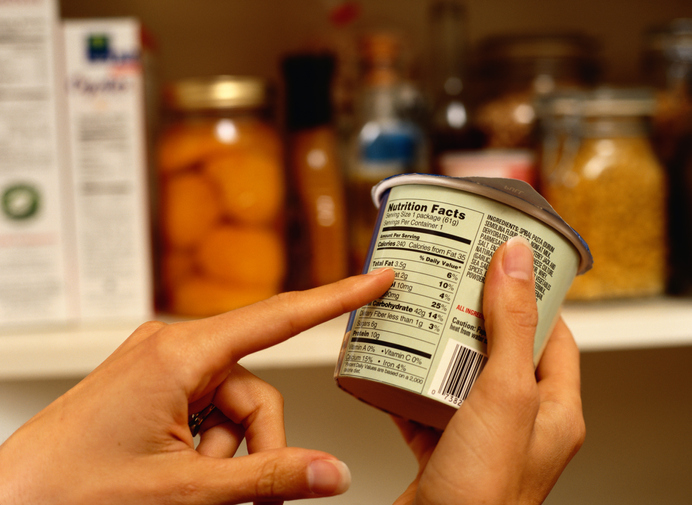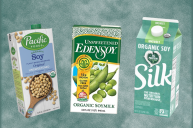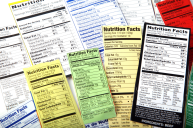When you think of natural food, what do you picture? Sunny pastures, maybe a barn? Food manufacturers pander to this aesthetic with their packages — your first impression of their product. They may do it subtly by adding the color green or using a matte finish. Or, they could just slap the word "natural" on it. The problem for us is, the government doesn't regulate the claim "natural." That means the ingredients could be 100% processed, and food manufacturers could legally call it "all-natural."
From 2015-2016, the Food and Drug Administration (FDA) asked for public input on the use of the term all-natural in labeling. Many commenters asked for natural to be synonymous with organic, non-GMO, and no additives or artificial colors. Others wanted the usage of natural removed altogether, saying it had no relation to health and was therefore misleading. No official regulation has been made since the public comment period has closed.

Getty Images
But, there is a similar term that's actually regulated — organic. The U.S. Department of Agriculture (USDA) outlines specific standards for food to be certified organic. For example, crop pests must be managed primarily through physical, mechanical, and biological controls. Synthetic substances are allowed, but only if they're approved on the National List. The use of genetic engineering is prohibited. Livestock must be fed 100% organic feed, and so on. If you're among those who think natural should be synonymous with organic and non-GMO, look for the USDA Organic Seal.
If "natural" has no bearing on what's in the package, how do you know what you're actually getting? Flip over the package and read the ingredients list.
How to Read the Ingredients List
Timaree Hagenburger, registered dietitian and author of The Foodie Bar Way, recommends we ask ourselves three questions as we read the list of ingredients on every food label:
- Do I actually want these in my body?
- Are these going to promote health or disease?
- What am I really paying for?
The most prominent ingredients are listed higher in the list. As a general rule, the first three ingredients make up the bulk of whatever you're buying.

Getty Images
Ultimately, the best way to eat all-natural ingredients is to eat whole foods in their most natural state, for example, fresh apples instead of dried apples or apple breakfast bars. In these processed products, there are likely added sugars and oils — all of which will be listed in the ingredients.
Here are a few ingredients to look for. Remember, naturalness does not equate to health.
Refined ingredients
"On a food label, I think of the word 'refined' as a message to consumers: 'We processed the health-promoting nutrients right out of those grains,'" says Hagenburger.
Although, food manufacturers can workaround using the word refined. Take bread for example. Multigrain seems healthy, right? But that just means the product contains a mixture of grains, all of which could possibly be refined. If you want a more natural product, read the ingredients and look for "whole" or "whole grain" as the first item in the list.
Oils

Getty Images
"If oil is listed as an ingredient, it's no longer part of the whole food," says Hagenburger. "That process separates the lipids from the fiber and the other beneficial phytonutrients. Creating commonly used cooking oils, especially those used in processed food, is very much an industrialized process."
Choosing whole food sources of fats in their natural form and eliminating oils will truly support health, according to Hagenburger.
"It makes it much easier to avoid junk food when you avoid those ingredients," says Hagenburger. "Because when you look for foods without oil in the ingredient list, you're going to pass up a lot of those crummy snack foods, also made with refined flour, processed sweeteners and preservatives, that aren't doing anybody's body any favors."
Processed sugar
Sugar and salt go by many different names. Processed sugars sneak in as corn syrup, high-fructose corn syrup, agave nectar, evaporated cane juice, dextrose, or malt syrup. Much like oil, processed sugars derived from plants are missing many of their natural components.
Other additives and artificial ingredients
Preservatives, artificial colors, and other additives also have complex names. Examples you may see on the label include:
- Preservatives: ascorbic acid, sodium benzoate, potassium sorbate, tocopherols
- Emulsifiers that prevent separation of liquids and solids: soy lecithin, monoglycerides
- Thickeners to add texture: xanthan gum, pectin, carrageenan, guar gum
- Colors: artificial FD&C Yellow No. 6 or natural beta-carotene to add yellow hues
The next time you are in the grocery store take a few minutes to read the label. All-natural may not mean healthier.
Crystal Gwizdala is a freelance science journalist based in mid-Michigan. When she's not writing, eating, or sleeping on the floor, you can find her trekking through the woods or rambling on about some hypothetical trip she has planned. Read Crystal's work in The Xylom, Woman&Home, and Catalyst Midland, or follow her on Twitter.




